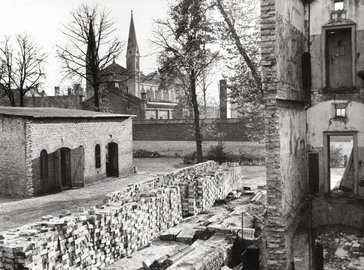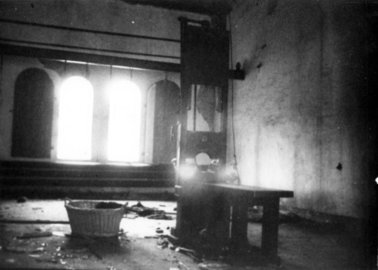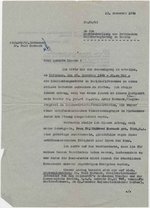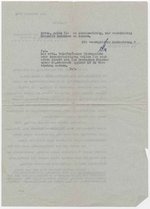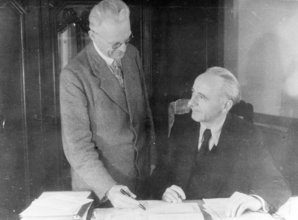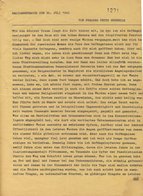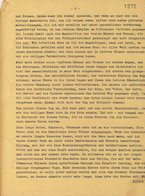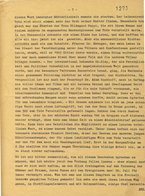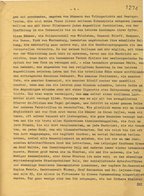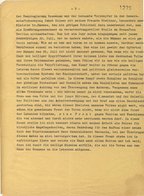The Situation in 1945
Plötzensee prison was severely damaged during the Allied air raid on Berlin on the night of September 3, 1943. Bombs hit House III, where those condemned to death spent the last few hours before their execution, and part of the execution shed. The murders continued unabated, however. Some 33 prisoners were executed in Plötzensee prison as late as April 18, 1945. A week later, on April 25, 1945, Soviet troops captured the grounds of the largely evacuated prison.
After the end of the war, the Allies ruled that Plötzensee prison was to be used as a juvenile detention facility. There were early initiatives by the Allies and the associations of victims of National Socialism to record the names and countries of origin of those murdered. Most of the latter had been buried anonymously. For their relatives, the former execution site at Plötzensee was an important place of individual mourning and joint remembrance.
Letter from Falk Harnack to the British military administration
Since the former execution site is located on the grounds of Plötzensee prison, it was not open to the public. Falk Harnack wrote to the legal department of the British military administration on December 13, 1948.
He wanted to commemorate his brother Arvid and sister-in-law Mildred in the former execution shed on the anniversary of his brother’s death. Arvid Harnack was murdered there on December 22, 1942, and his wife Mildred on February 16, 1943. Their mortal remains were cremated at the Berlin-Wilmersdorf crematorium and buried at an unknown location.
Peter Buchholz January 31, 1888 – May 4, 1963
Peter Buchholz studied Catholic theology and was ordained as a priest at Cologne cathedral in 1911. He went on to become a chaplain in Essen and served as a military chaplain in the First World War. In 1926 he began working as a prison chaplain in Essen and Düsseldorf. He was transferred to Plötzensee prison as a chaplain in 1943, and provided pastoral care to many of the prisoners who received death sentences. Despite being banned from doing so, he sought contact to the men and women sentenced to death after the attempted coup of July 20, 1944, and reported their fates to their families after the end of the war.
In 1945/46 he was an advisor to the Greater Berlin municipal administration on church affairs and was involved in planning the establishment of a memorial site in Plötzensee, along with Provost Heinrich Grüber. He returned to his home diocese in 1946, once again working as a prison chaplain. In post-war Germany, Peter Buchholz was a devoted advocate for commemorating victims of National Socialism.
Radio speech by the prison chaplain Peter Buchholz, held July 20, 1945
The Catholic prison chaplain held a speech on the Berliner Rundfunk radio station, drawing public attention to the fate of those imprisoned and murdered in Plötzensee. He spoke of his encounters with the men and women executed in Plötzensee, and paid tribute to the resistance against National Socialism that emerged from many different religious and ideological standpoints.
And we—we bow down in awe of these dead, who in dying for freedom became our dead. I see a long line passing beside me, hundreds, thousands. Their names have gone down in their nations’ history.
Father Peter Buchholz in his radio speech on July 20, 1945.
In June 1945, the Commission for the Victims of Fascism (OdF) was founded within the Berlin municipal authorities. The commission worked to meet the material needs of victims of National Socialism and advocated worthy remembrance. At the commission’s suggestion, the first Day of Commemoration for the Victims of Fascism was held in September 1945.
On September 22, 1946, a mass rally took place in Berlin’s Lustgarten to mark the occasion. The event focused on tributes to the German resistance.
Arthur Werner and Marion Gräfin Yorck von Wartenburg, who are shown in the film, began campaigning for the establishment of a memorial site in Plötzensee shortly later.

![[Translate to english:] Landesarchiv Berlin, F Rep. 290, Nr. 0007278 / Foto: Bert Sass](/pl_content/_processed_/d/c/csm_0108162001.0101326b_01f2c9ec6a.jpg)
